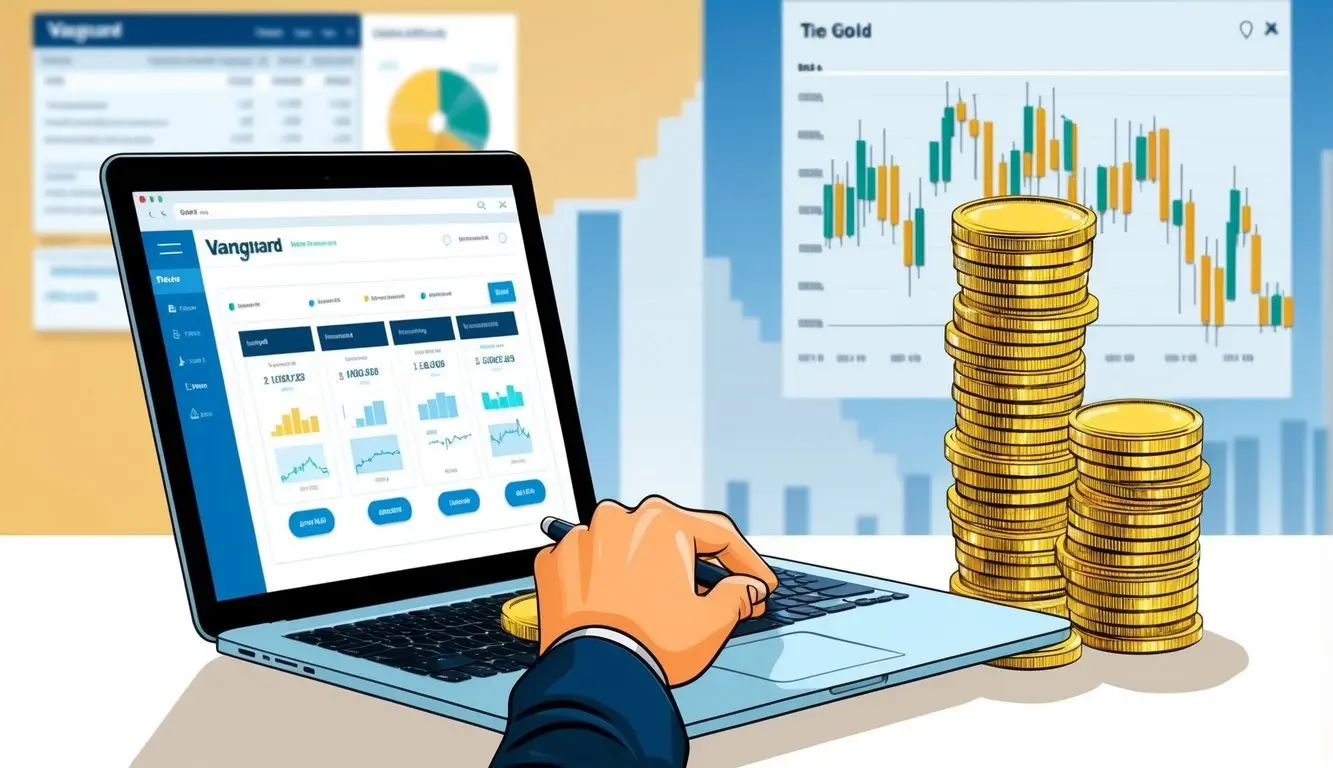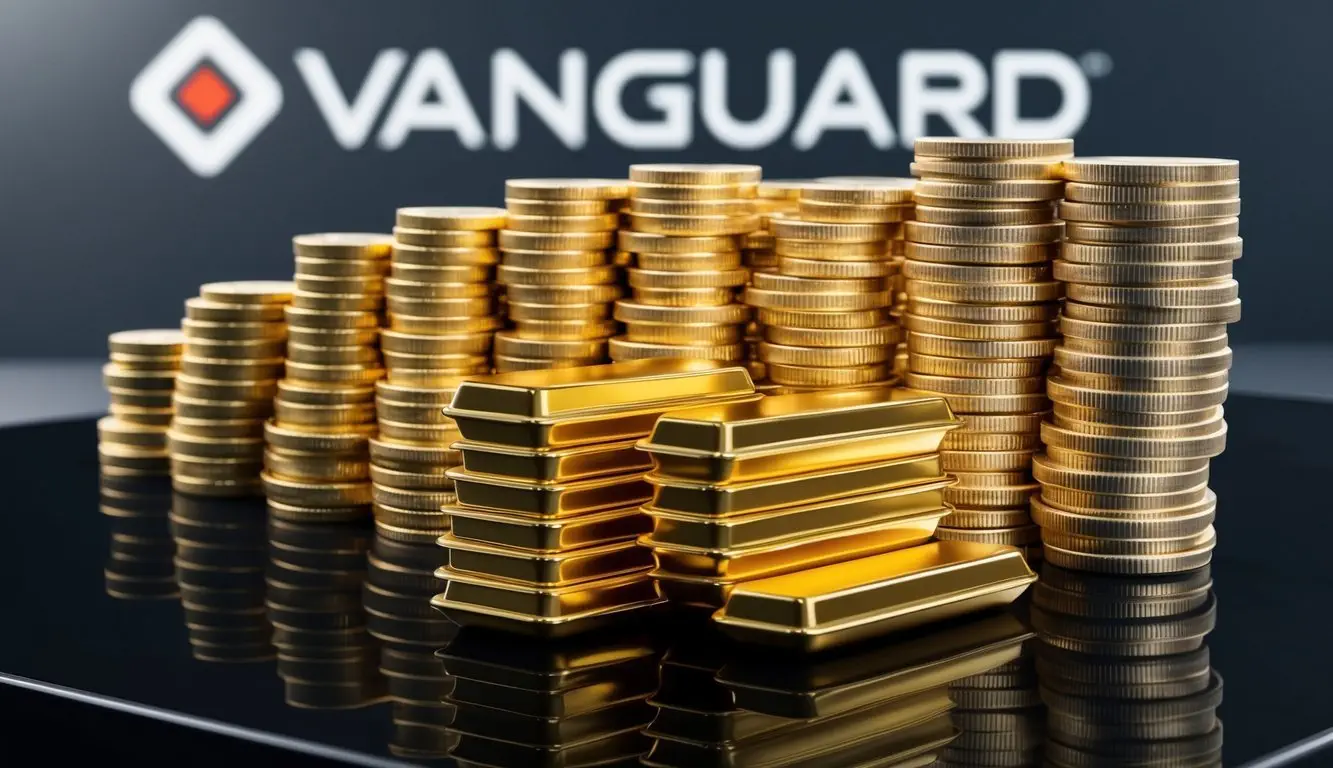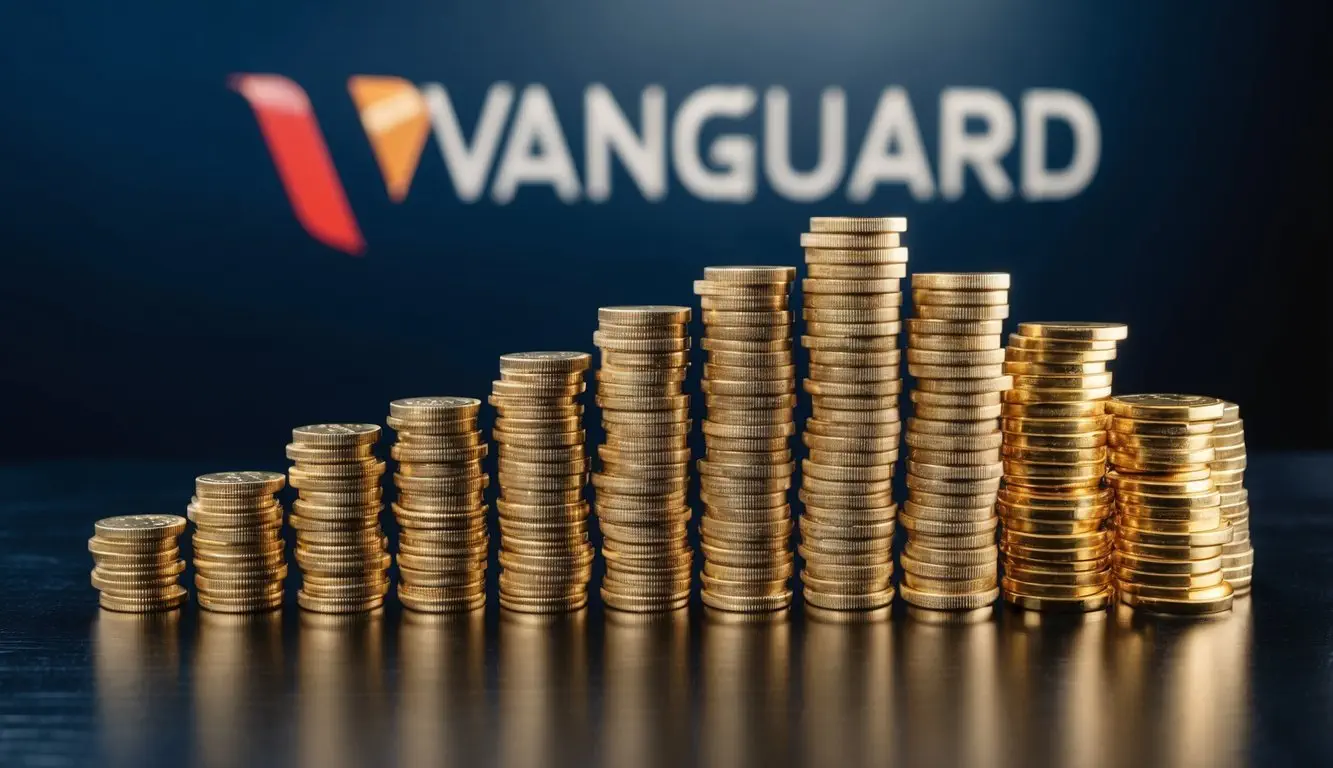Investing in gold can add diversity to your investment portfolio. Many investors look to Vanguard, a trusted name in the financial world, for options to include this precious metal in their strategy.

Yes, you can invest in gold through Vanguard by purchasing their specialized Gold ETFs such as Vanguard Global Capital Cycles Fund (VGPMX) or by buying ETFs that track gold prices like VanEck Vectors Gold Miners ETF (GDX) through a Vanguard brokerage account. These options allow investors to gain exposure to gold without the challenges of storing physical gold.
Vanguard’s approach to gold investment focuses on providing low-cost access to the gold market. Their platform enables both new and experienced investors to include gold in their investment portfolios as a potential hedge against inflation or market volatility.
Understanding Gold as an Investment

Gold has maintained its value throughout human history, offering investors a unique asset that can enhance portfolio stability. It behaves differently from stocks and bonds, providing protection when other investments falter.
Historical Significance of Gold
Gold has been a symbol of wealth for thousands of years. Ancient civilizations from Egypt to Rome used gold as currency and a store of value. Unlike paper money, gold cannot be created out of thin air by governments.
During economic crises, gold often retains its purchasing power. The 1970s saw gold prices soar when inflation surged. Similarly, during the 2008 financial crisis, gold performed well while stocks plummeted.
Central banks around the world still hold large gold reserves. These reserves serve as a financial backstop and signal economic strength to other nations.
Gold’s Role in Diversification
Gold typically moves independently of stocks and bonds. When stock markets decline, gold often rises or holds steady. This negative correlation makes it valuable for diversification.
In investment portfolios, even a small 5-10% allocation to gold can reduce overall volatility. During market downturns, this portion may help offset losses elsewhere.
Physical gold doesn’t generate income like dividend stocks or bonds. However, it serves as “insurance” against severe market disruptions and currency devaluation.
Many financial advisors recommend gold as a hedge against inflation. When the dollar weakens, gold prices often strengthen, preserving purchasing power.
Gold vs. Other Investment Vehicles
Gold offers several investment options. Physical gold includes coins and bars, providing direct ownership but requiring secure storage. Gold ETFs offer easier trading without storage concerns.
Gold mining stocks present another option, offering potential dividends and leverage to gold prices. However, these companies face business risks beyond just gold price movements.
| Investment Type | Advantages | Disadvantages |
|---|---|---|
| Physical Gold | Direct ownership, privacy | Storage costs, insurance needs |
| Gold ETFs | Easy trading, low fees | No physical possession |
| Mining Stocks | Potential dividends, leverage | Company-specific risks |
Unlike stocks or bonds, gold doesn’t produce anything or generate cash flow. Its value comes from its scarcity and investor perception rather than productive capacity.
During periods of market volatility, precious metals often outperform other assets. This makes gold particularly attractive when uncertainty is high.
Can You Invest in Gold Through Vanguard

Vanguard offers investors several options to gain exposure to gold in their portfolios. These options align with Vanguard’s overall investment approach while providing access to this precious metal as an alternative asset.
Vanguard’s Investment Philosophy
Vanguard follows a long-term, low-cost investment approach focused on broad diversification. The company generally views gold as a speculative investment rather than a core holding. This perspective stems from gold’s lack of cash flows and reliance solely on price appreciation for returns.
Vanguard’s founder, John Bogle, often cautioned against overweighting gold in portfolios. He emphasized that while gold can serve as a hedge against inflation and currency devaluation, it should represent only a small portion of a well-diversified portfolio.
Despite this conservative stance, Vanguard recognizes that some investors want gold exposure. They accommodate this need through specific investment vehicles rather than recommending direct physical gold ownership.
Available Gold Investment Options
Vanguard offers indirect gold exposure primarily through ETFs and mutual funds. The Vanguard Materials ETF (VAW) includes companies involved in gold mining, providing partial exposure to gold price movements.
For more direct gold investment, investors can purchase the VanEck Vectors Gold Miners ETF (GDX) through Vanguard’s brokerage platform. This ETF tracks companies primarily involved in gold mining.
Vanguard doesn’t offer:
- Physical gold storage
- Gold certificates
- Direct gold bullion funds
Investors seeking pure gold exposure can use Vanguard’s brokerage services to purchase specialized ETFs like SPDR Gold Shares (GLD) or iShares Gold Trust (IAU). These third-party ETFs track gold prices more directly than Vanguard’s own offerings.
Analyzing Vanguard’s Gold ETFs
Vanguard’s approach to gold ETFs emphasizes low expense ratios and broad exposure. The Vanguard Materials ETF (VAW) has an expense ratio of just 0.10%, significantly lower than many gold-specific funds that average 0.40-0.50%.
Performance characteristics of Vanguard’s indirect gold options differ from pure gold investments. During market volatility in 2020:
| Investment Type | Performance During Market Stress | Correlation with S&P 500 |
|---|---|---|
| Direct Gold ETFs (GLD) | +24.8% | -0.23 (negative) |
| Vanguard Materials ETF (VAW) | +12.1% | +0.78 (positive) |
For retirement savings, Vanguard typically recommends limiting gold exposure to 5-10% of a portfolio. This allocation provides modest inflation protection without overexposure to gold’s price volatility.
Key Considerations for Gold Investors
When adding gold to your investment portfolio, several factors can impact your success. Understanding these elements will help you make more informed decisions about how gold fits into your financial plans.
Assessing Risk and Market Volatility
Gold prices can swing dramatically based on economic conditions, making volatility a key consideration. During economic uncertainty, gold often performs well as investors seek safe havens.
However, gold can also experience long periods of flat or negative returns. From 2011 to 2015, gold prices dropped over 40% after reaching record highs.
A smart approach is to limit gold to 5-10% of your total investment portfolio. This provides potential protection without overexposure to market swings.
Gold’s performance often moves opposite to stocks, which makes it valuable for diversification. During the 2008 financial crisis, gold gained value while many stock markets plummeted.
Before investing, review gold’s price history over different time periods to understand its volatility patterns.
Impact of Expense Ratios on Returns
Expense ratios directly affect your gold investment returns, especially over long periods. Vanguard’s gold funds typically offer lower expense ratios than many competitors.
For example, some gold ETFs charge 0.25-0.40% annually, while specialized gold funds might charge 0.50-1.00% or higher. These fees compound over time.
A 0.5% difference in expense ratio on a $10,000 investment could mean $1,600 less in returns over 20 years, assuming similar performance.
When comparing gold investment options, look beyond just the fund name or strategy. Check the expense ratio in the fund’s prospectus or on Vanguard’s website.
Lower-cost options typically include broad-based ETFs rather than actively managed gold funds.
Strategies for Investing in Gold for Retirement
Adding gold to retirement accounts requires specific approaches. Vanguard offers gold exposure through IRAs with several investment options.
Dollar-cost averaging works well with gold investments. By regularly purchasing gold ETFs regardless of price, you can reduce the impact of market volatility.
For retirement planning, consider your time horizon. Younger investors might allocate more to gold for long-term growth, while those near retirement might use it as a portfolio stabilizer.
Rebalancing is essential with gold investments. Set a target allocation and adjust annually to maintain your desired exposure.
Gold shouldn’t replace traditional retirement investments like stock and bond funds. Instead, it should complement them by adding diversification to your portfolio.
How to Invest in Gold with Vanguard

Vanguard offers several ways to add gold to your investment portfolio without buying physical gold. These options include gold ETFs and mutual funds that focus on precious metals.
Step-by-Step Guide to Buying Gold ETFs
To start investing in gold through Vanguard, you’ll need a Vanguard brokerage account. If you don’t have one, visit Vanguard’s website and click “Open an account.” The process takes about 10 minutes to complete.
Once your account is set up, follow these steps:
- Log in to your Vanguard account
- Select “Trade” from the main menu
- Choose “ETFs” from the trading options
- Search for gold ETFs like VanEck Vectors Gold Miners ETF (GDX) or SPDR Gold Shares (GLD)
- Enter the number of shares you want to buy
- Review and submit your order
Vanguard charges no commission for ETF trades. The minimum investment depends on the ETF’s share price, making it accessible for most investors.
Managing Your Gold Investments
After purchasing gold ETFs, monitor them regularly through your Vanguard dashboard. Most investors consider gold a long-term holding that shouldn’t exceed 5-10% of their total portfolio.
Gold investments serve as a hedge against inflation and provide portfolio diversification. They often move differently than stocks and bonds during market turbulence.
Consider setting up automatic investments if you want to build your gold position gradually. This strategy, called dollar-cost averaging, can reduce the impact of gold’s price volatility.
Rebalance your portfolio periodically to maintain your desired allocation to gold. Vanguard offers portfolio analysis tools that show how your investments align with your goals.
Investment Tips for Potential Gold Investors
Gold can be a valuable addition to your investment portfolio when approached wisely. Here are some practical tips to help you navigate gold investments effectively.
Start small and diversify. Financial experts often recommend limiting gold to 5-10% of your overall investment portfolio. This provides potential benefits while managing risk.
Consider gold ETFs for convenience. Vanguard offers the Admiral Shares Gold and Precious Metals Fund (VGPMX), which gives you exposure to gold without physical storage concerns. ETFs typically have lower fees than actively managed funds.
Physical gold options require more consideration. If you choose this route, understand storage costs, insurance needs, and authentication requirements for coins or bars.
Remember that gold doesn’t pay dividends or interest. Its value comes from price appreciation, which can be unpredictable in the short term.
For retirement savings, consider adding gold investments to your IRA. Vanguard’s brokerage services allow you to purchase gold ETFs within retirement accounts for tax advantages.
Research historical performance before investing. Gold often moves differently than stocks and bonds, which can help balance portfolio volatility during market downturns.
Be wary of high-pressure sales tactics or “limited time” gold investment opportunities. Reputable options like Vanguard’s offerings provide transparency and reasonable fee structures.
Monitor your gold investments regularly but avoid frequent trading based on short-term price movements. Gold typically serves as a long-term hedge rather than a quick profit vehicle.
Frequently Asked Questions

Investors often have specific questions about accessing gold through Vanguard’s investment options. These common queries address fund choices, comparisons with competitors, performance trends, and the practical aspects of gold investing.
What Vanguard funds are available for gold investment?
Vanguard offers limited options for gold investment compared to other firms. The main option is the Vanguard Precious Metals and Mining Fund (VGPMX), which invests in companies involved in mining and production of gold and other precious metals.
This fund doesn’t invest directly in physical gold but rather in businesses connected to the precious metals industry. Vanguard also allows investors to purchase gold ETFs from other providers through their brokerage platform.
How does the Vanguard Gold ETF compare to other gold investment options?
Vanguard doesn’t offer its own dedicated gold ETF. When investors discuss “Vanguard Gold ETF,” they’re typically referring to gold ETFs available through Vanguard’s brokerage services.
Popular gold ETFs accessible through Vanguard include SPDR Gold Shares (GLD) and iShares Gold Trust (IAU). These ETFs typically have different expense ratios and minimum investment requirements compared to physical gold or gold mining stocks.
What are the performance trends of the Vanguard Precious Metals and Mining Fund?
The Vanguard Precious Metals and Mining Fund (VGPMX) has shown volatility aligned with precious metals markets. This fund has experienced periods of both strong performance and significant declines.
In recent years, the fund has sometimes underperformed broader market indexes during bull markets but provided diversification benefits during certain economic downturns. Past performance indicates sensitivity to global economic conditions and commodity price cycles.
Can you invest in gold and precious metals ETFs through Vanguard?
Yes, investors can purchase gold and precious metals ETFs through Vanguard’s brokerage platform. Popular options include SPDR Gold Shares (GLD), iShares Gold Trust (IAU), and Aberdeen Standard Physical Gold Shares ETF (SGOL).
These ETFs can be bought and sold like any stock through a Vanguard brokerage account. Commission-free trading applies to many ETFs on Vanguard’s platform, making these investments more accessible.
How can I find the current price of Vanguard Gold ETF?
Since Vanguard doesn’t offer its own gold ETF, you’ll need to search for specific third-party gold ETFs available through Vanguard’s platform. Current pricing can be found on Vanguard’s website or mobile app by searching the specific ticker symbol.
For example, search for “GLD” or “IAU” to find current prices for popular gold ETFs. Financial news websites, brokerage platforms, and market tracking services also provide real-time or delayed quotes for these investments.
What are the advantages and disadvantages of investing in VGPMX?
Advantages of investing in VGPMX include professional management, diversification across multiple mining companies, and lower entry costs than purchasing physical gold. The fund provides exposure to precious metals without storage concerns.
Disadvantages include higher volatility than direct gold ownership, exposure to company-specific risks, and management fees. The fund may underperform physical gold during certain market conditions since mining stocks don’t always move in perfect correlation with gold prices.